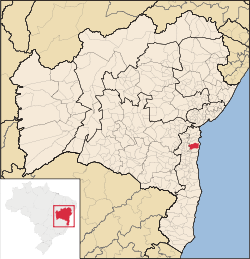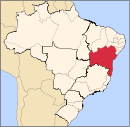Camamu
Camamu | |
|---|---|
Municipality | |
 Municipality of Camamu in Bahia state | |
| Country | |
| Region | Nordeste |
| State | Bahia |
| Area | |
• Total | 341.8 sq mi (885.2 km2) |
| Population (2020 [1]) | |
• Total | 35,382 |
| Time zone | UTC−3 (BRT) |
Camamu is a municipality in the state of Bahia, Brazil. Politically, it is in the Valença subregion of the Sul Baiano region.[2] It is located on the southern coast of Bahia state, the Costa do Dendê (Palm Coast), along the BA-001 highway. The municipality covers an area of 885.20 km2, and, in a 2020 estimate, it had 35,382 inhabitants.[3][4]
History
[edit]The region was originally inhabited by native Macamamus Indians.[5][6] The name Camamu was the name of the Indians' village. In 1560 the Jesuits established a mission, that the next in year, upon completion of the chapel, was converted into a parish with the name "Aldeia de Nossa Senhora da Assunção de Macamamu".[7] On 22 May 1693 the village was elevated to town status with the name of Camamu. And finally, on June 27, 1891, it officially became a city.[7]
Like many coastal towns, Camamu was built at two levels. In the upper town were the churches and colonial houses, while down by the harbor were the commercial establishments.
The town grew rich as the area became the largest producer of cassava in Brazil, and it became the target of pirates and invaders such as the Dutch. From 1624 to 1627 the town suffered several attacks by the Dutch. To protect itself from further incursions, the inhabitants blocked the passage to the harbor with huge rocks, that forced boats to zigzag in the channel in order to reach the port. The rocks remain in place today.
In 1782, by order of the Portuguese Crown, the pioneer João Gonçalves da Costa opened the first road connecting Camamu with inland settlements. Because of its importance to the economic life of the province, it became known as the "Estrada das Nações" ("Road of Nations").
In 1961, Camamu municipality was subdivided with a portion remaining in Camamu and a portion becoming the municipality of Ibirapitanga.
In 2008 the Comptroller General in his audit cited municipal officials for widespread corruption.[8]
Geography
[edit]Pedra Furada Island and the Maraú Peninsula enclose a deep bay, Camamu Bay (Baía de Camamu), in which the town of Camamu is located. Highway BA-650 runs west to the city of Ibirapitanga.
The municipality contains 33.28% of the 118,000 hectares (290,000 acres) Baía de Camamu Environmental Protection Area, created in 2002.[9]
Economy
[edit]The area produces rubber and barite is mined.[7] The major agricultural product is cattle.[7]
See also
[edit]Notes
[edit]- ^ IBGE 2020
- ^ "Divisão Territorial do Brasil" (in Portuguese). Divisão Territorial do Brasil e Limites Territoriais, Instituto Brasileiro de Geografia e Estatística (IBGE). July 1, 2008. Retrieved December 17, 2009.
- ^ "Ranking decrescente do IDH-M dos municípios do Brasil" (in Portuguese). Atlas do Desenvolvimento Humano, Programa das Nações Unidas para o Desenvolvimento (PNUD). 2000. Archived from the original on October 3, 2009. Retrieved December 17, 2009.
- ^ "Produto Interno Bruto dos Municípios 2002-2005 (Gross Domestic Product at current prices and GDP per capita by Major Regions, Federation Units and Municipalities - 2002-2005)" (PDF) (in Portuguese). Instituto Brasileiro de Geografia e Estatística (IBGE). December 19, 2007. Archived from the original (PDF) on October 2, 2008. Retrieved December 17, 2009.
- ^ The Indians from Camamu Bay south to the São Mateus River were called Tupiniquim. Freire, Carlos Augusto da Rocha (July 1998). "Tupiniquim: In colonial times and during the Empire and the Old Republic". Instituto Socioambiental. Archived from the original on 3 February 2013.
- ^ What is left of the indigenous population is classified under the grouping "Pataxó Hã-Hã-Hãe" "Pataxó Hã-Hã-Hãe". Enciclopédia dos Povos Indígenas no Brasil. Instituto Socioambiental. 2011.
- ^ a b c d Carletto, Ronaldo (27 June 2007). "Manifesta Moção de Congratulações pela emancipação política e administrativa do município de Camamú". Assembleia Legislativa do Estado da Bahia. Archived from the original on 29 November 2014. Retrieved 3 February 2013.
- ^ Jorge Hage Sobrinho, the Comptroller-General, cited numerous irregularities in bidding and delivery of services. He noted the use of ghost companies to funnel away state funds, the failure to provide contracted services and the purchase of equipment for which the municipality had no use. Staff (6 June 2008). "Em Camamu/BA, muitas irregularidades em licitações (In Camamu / BA, many irregularities in bids)". Controladoria-Geral da União (CGU). Archived from the original on 25 November 2009. Retrieved 2 February 2013.
- ^ APA da Baía de Camamu (in Portuguese), ISA: Instituto Socioambiental, retrieved 2016-10-28
External links
[edit]- "A Cidade de Camamu (City of Camamu)". Camamu.net., includes a map of the area

